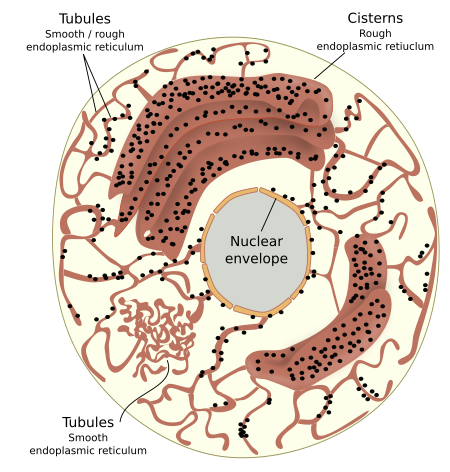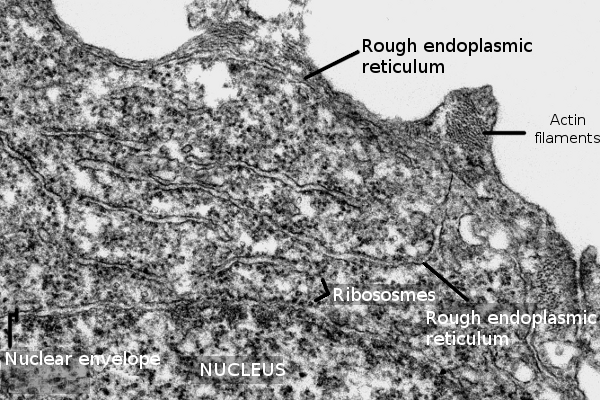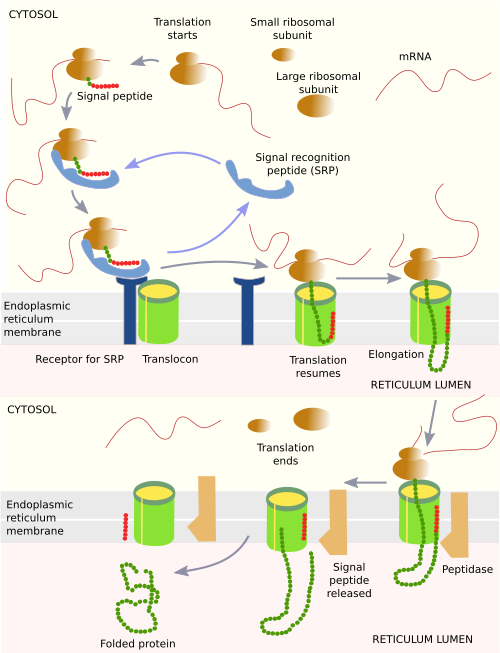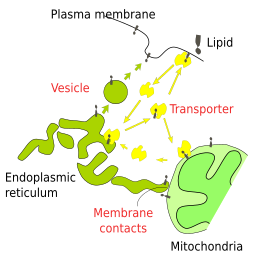1. Rough
- Protein synthesis
2. Smooth
- Lipids
- Detoxification
- Glucose 6-P
- Calcium
The endoplasmic reticulum is a complex membrane-bound compartment arranged in interconnected tubules and flattened cisterns that share the same lumen (inner space) and membrane. The endoplasmic reticulum membrane is also continuous with the outer membrane of the nuclear envelope. Tubules and cisterns are distributed through the cytoplasm, from the nuclear envelope to the plasma membrane, and they can account for half of the total cellular membranes. In addition, the endoplasmic reticulum membrane is thinner (around 5 nm in thickness) than other organelle membranes.
The endoplasmic reticulum is organized in three domains or regions that carry out distinct functions. Rough endoplasmic reticulum membranes contain associated ribosomes (that is why the name rough) to the cytosolic surface, and these membranes are arranged in cisterns and in more or less straight tubules (Figure 1). Smooth endoplasmic reticulum is organized in irregular and convoluted tubules, with no associated ribosomes. The nuclear envelope may be regarded as a third domain because it is physically continuous with the membranes of the endoplasmic reticulum. Although the nuclear envelope performs specific functions, ribosomes associated with the outer membrane of the nuclear envelope are observed.

Rough and smooth endoplasmic reticulum do not usually share the same cytoplasm space. This non-overlapping distribution is observed in hepatocytes, neurons and cells synthesizing steroid hormones. However, in some regions, there is no clear segregation between both domains, and tubules with associated ribosomes are intermingled with naked tubules. The spatial distribution of the endoplasmic reticulum through the cytoplasm is set by interactions with the cytoskeleton,, mostly microtubules in animal cells and actin filaments in plant cells.
The endoplasmic reticulum is involved in the formation of peroxisomes and lipid droplets. We will deal with these processes in the next pages.
1. Rough endoplasmic reticulum
The rough endoplasmic reticulum is organized in more or less straight tubules and flattened cisterns, with many ribosomes associated with their membranes. Sometimes, cisterns are tidily piled. (Figures 1 and 2). The density of associated ribosomes influences the rough endoplasmic reticulum membrane organization, so that a high density causes a cistern-like morphology, whereas lower density is found in tubules.

Protein synthesis
Protein synthesis is the main function of the rough endoplasmic reticulum. These proteins end up at different places: a) the extracellular space, b) the lumen of organelles involved in the vesicular trafficking, c) as integral part of membranes, both plasma membrane and membrane of cell organelles participating in the vesicular trafficking, d) and as resident proteins. The endoplasmic reticulum needs to synthesized proteins for itself, which are known as resident or constituent proteins. Resident proteins are retained in the endoplasmic reticulum because they contain a four amino acid sequence close to the end carboxyl group.
All these proteins begin to be synthesized by the free ribosomes in the cytosol, but the synthesis ends in the endoplasmic reticulum, leaving the protein either free in the lumen or as part of the reticulum membrane (Figure 3). The process of protein synthesis starts when an mRNA joins a small ribosomal subunit, and then a large ribosomal subunit, to begin the translation. The first translated segment of the mRNA is a sequence of amino acids known as signal peptide, which is about 70 amino acids long. This sequence is recognized by a cytosolic molecule called SRP (sequence recognition particle) and then the translation process slows down. The mRNA-ribosome-SRP-signal-peptide complex diffuses through the cytosol until it hits a endoplasmic reticulum membrane. In these membranes, there are SRP-receptors for recognizing the bonded SRP. The whole complex becomes attached to the membrane and then interacts with a translocon, a large transmembrane protein with a channel. SRP and SRP-receptor are released and the mRNA-ribosome-signal-peptide complex is attached to the translocon. After that, translation is resumed and the nascent polypeptide grows now inside the translocon channel. If the final protein is soluble in the lumen, a peptidase in the reticulum cleavages the signal peptide, while the rest of the protein falls into the lumen of the endoplasmic reticulum. The polypeptide is quickly folded by chaperones to get a proper spatial conformation. When translation is finished, the ribosome-mRNA is disengaged from the translocon, and they are free for another round.

Transmembrane proteins contain sequences of hydrophobic amino acids. When these sequences are being translated and going through the translocon channel, they can cross the wall of the translocon and get among the fatty acid chains of membrane lipids. The process is rather complex and diverse depending on the protein. For instance, some receptors are transmembrane proteins with a chain of amino acids that can cross seven times the cell membrane. Although it is not common in animal cells, the endoplasmic reticulum may import some proteins completely synthesized in the cytosol thanks to other proteins associated with its membrane.
Proteins in the rough endoplasmic reticulum are modified while they are being synthesized. a) Asparagine amino acids are glycosysilated (N-glycosylation) with a molecular complex composed of 15 monosaccharides. This molecular tree is first assembled into a molecule of dolichol phosphate, a membrane lipid, and then is transferred to an asparagine of the nascent protein. In the Golgi apparatus, some terminal monosaccharides of this complex will be lost, and other saccharides will be added. b) Some proteins, mostly those targeted to the extracellular matrix, are hydroxylated. In this way, proline and lysine amino acids of the collagen molecules end up being hydroxyproline and hydroxylysine amino acids. c) Some proteins of the plasma membrane are chemically bonded to some membrane lipids. This chemical bond is also established in the rough endoplasmic reticulum. d) Disulfide bonds between polypeptide chains are formed in the endoplasmic reticulum..
A quality control of synthesized proteins occurs in the rough endoplasmic reticulum, so that those defective proteins are removed from the reticulum and degraded in the cytosol. Proteins known as chaperones, which are needed for a proper folding of newly synthesized proteins, also play an essential role in detecting defective proteins and targeting them for degradation. Other proteins bearing lectin domains are able to detect and recognize wrong arrangements of carbohydrates. Wrong folding of nascent proteins, which may lead to cell damages, is more frequent than one may expect, and it is more frequent during cellular stress.
2. Smooth endoplasmic reticulum
The smooth endoplasmic reticulum is a network of interconnected tubules, which are continuous with the rough endoplasmic reticulum. There are no ribosomes associated with its membrane, therefore it is named smooth. The majority of proteins in this compartment comes from the rough endoplasmic reticulum domain. The smooth endoplasmic reticulum is abundant in those cells involved in lipid metabolism, detoxification, and it is a calcium storage for the cell.
Lipid synthesis
Most membrane lipids are synthesized in the smooth endoplasmic reticulum, including glycerophospholipids and cholesterol. Although a large part of the sphingolipid molecules are assembled in the Golgi apparatus, their basic component ceramide is synthesized in the endoplasmic reticulum. The smooth endoplasmic reticulum is actually a platform for assembling membrane lipids. Thus, fatty acids synthesized in the cytosol, or coming from food, are inserted in the cytosolic monolayer of the organelle membrane, and then other molecules are sequentially added to form glycerophospholipids. Since flip-flop movement is nearly forbidden for lipids because of the hydrophobic environment of fatty acid chains, lipids need help to be transferred to the other monolayer (that facing the lumen). There are specialized proteins that can move lipids from one monolayer to the other: flippases, floppases and scramblases.
Transferring lipids between organelles is done by vesicles, molecular carriers and at membrane physical contact sites (Figure 4). Through vesicular trafficking, vesicles transport the bulk of lipids as part of their own membranes between cell organelles. Mitochondria, chloroplasts and peroxisomes are not major players of the vesicular trafficking, so some membrane lipids are synthesized locally, but many others are imported from the endoplasmic reticulum by molecular carriers. For example, glycerophospholipids are transported by a cytosolic protein known as glycerophospholipid interchanger. It can take a lipid from the membrane of the smooth endoplasmic reticulum and leaves it in the membrane of other organelle. Another way to transfer lipids between organelles occurs at the membrane contact sites. These contacts may facilitate interchange of lipids between different membranes.

Cholesterol is a major component of post-Golgi membranes, mostly synthesized in the smooth endoplasmic reticulum. It is transported by vesicles and molecular carriers from the endoplasmic reticulum. In yeasts, that have ergosterol in their membranes instead of cholesterol, the main mechanism to move ergosterol from the endoplasmic reticulum to the plasma membrane is a diverse set of ATP-independent transporters.
Triacylglycerols are also synthesized in the smooth endoplasmic reticulum. These lipids are stored in the reticulum itself or as lipid droplets. The synthesis of triacylglycerols is intense in adipocytes, the fat storing cells of animals. The overproduction of lipids is stored in cytoplasmic lipid droplets. This fat-storing organelle works as an energy source for the body as needed, and in some species for thermal insulation as well. Lipids synthesize in the endoplasmic reticulum are also part of the lipoproteins, and needed for the synthesis of steroid hormones and bile acids.
Detoxification
Hepatocytes, the liver cells, show a heavily developed smooth endoplasmic reticulum. In the smooth endoplasmic reticulum membranes, the P450 protein family is in charge of removing potentially toxic metabolites, as well as liposoluble toxins incorporated during the digestion. The shape of the smooth endoplasmic reticulum tubules, and the lack of ribosomes, exposes a large surface of membrane. In addition, the length of the tubules is increase to make room for all these enzymes, which in turn depends on the amount of toxic substances.
Dephosphorylation of 6-phosphate glucose
Glucose is usually stored as glycogen, mainly in the liver. Two hormones regulate the glucose release from the liver to the blood: insulin and glucagon. Catabolism of glycogen produces 6-phosphate glucose, which cannot cross the cell membrane, and hence cannot leave the cell. Glucose 6-phosphatase, which is anchored to the endoplasmic reticulum, removes the phosphate residue, allowing glucose to be moved out of the cell.
Calcium storage
Smooth endoplasmic reticulum is also a place to intake calcium, which is stored in both rough and smooth endoplasmic reticulum. Calcium is transported into the lumen by calcium pumps located in the organelle membrane. Calcium concentration in the endoplasmic reticulum is in millimolar (mM), whereas in the cytosol is in nanomolar (nM). Stored calcium is released by extracellular and intracellular signals acting via second messengers, resulting in a cellular response, for example exocytosis. A remarkable example is the endoplasmic reticulum of the muscle cells (known as sarcoplasmic reticulum) that captures and releases calcium to produce a cycle of muscle cell contraction and relaxation.
-
Bibliography ↷
-
Bibliography
English AR, Zurek N, Voeltz GK. 2009. Peripheral ER structure and function. Current opinion in cell biology. 21:506-602.
Daleke DL. 2007. Phospholipid Flippases. The journal of biological chemistry. 282:821-825.
Nixon-Abell J, Obara, CJ, Weig VA, Li D, Legant WR, Xu CS, Pasolli HA, Harvey K, Hess HF , Betzig E, Blackstone C, Lippincott-Schwartz3 J. 2016. Increased spatiotemporal resolution reveals highly dynamic dense tubular matrices in the peripheral ER. Science. 354: 3928-2.
-
 Vesicular trafficking
Vesicular trafficking 